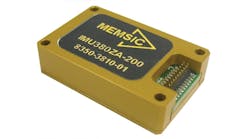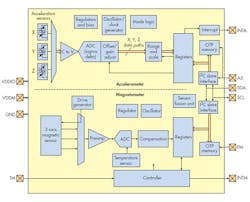Three-dimensional inertial measurement units (IMU) provide a device's specific force and angular rate using a combination of accelerometers and gyroscopes. IMUs often incorporate additional sensors like magnetometers to provide even more functionality.
By leveraging MEMS technology, an IMU is able to shrink to extremely small sizes. However, it can be challenging to deliver high performance across a broad spectrum of use cases, including wide temperature gradients encountered in applications areas such as automotive and avionics.
1. Analog Devices’ surface-mount ADIS16470 is a compact IMU that targets a range of applications, including the Internet of Moving Things.
Vendors often provide a range of IMU solutions to address these different applications. For example, the compact ADIS16470 (Fig. 1) from Analog Devices is designed for surface-mount assembly. It targets a range of applications, including the Internet of Moving Things (IoMT). The MEMS-based system includes 3D gyroscopes and 3D accelerometers, providing 6 degrees of freedom (6DOF). The gyroscopes feature a ±2000°/sec dynamic range, 8°/hr in-run bias stability, and 0.008°/sec/√Hz rms rate noise density. The SPI interface provides 3D delta angle and delta velocity outputs. It comes in a 11- × 15- × 11-mm, 44-ball BGA package.
Other members of Analog Devices’ IMU family are the ADIS16475 and ADIS16477. These have similar performance characteristics to the ADIS16470, but include a more ruggedized enclosure. This allows the devices to be used in applications like unmanned aerial vehicles (UAV) and smart agriculture.
Aceninna has range of strapdown 6DOF and 9DOF IMUs. This includes 9DOF high-performance navigation systems and attitude heading reference systems (AHRS) that incorporate Kalman filters with GPS-aided attitude/heading algorithms to provide accurate roll/pitch/heading in dynamic environments. They also offer 6DOF vertical gyroscopes with Kalman filter and attitude algorithm support.
2. The VG380ZA 9DOF vertical gyro weighs less than 17 g and uses less than 350 nW.
The company’s VG380 family includes the VG380ZA (Fig. 2), which is designed for OEM/embedded applications. The device comes in a 24- × 37- × 9.5-mm package and has an SPI/UART interface. It maintains an update rate up to 100 Hz and supports a temperature range from −40 C to +85 C. The VG380ZA can be used in UAVs and in uncertified avionics.
Different applications can take advantage of various combinations of sensors. For example, mCube’s MC6470 eCompass (Fig. 3) is a 6DOF device equipped with a 3-axis MEMS linear accelerometer and a 3-axis magnetic field sensor. It’s designed for mobile phones, fitness and other wearable products, as well as portable navigation devices. The 2- × 2-mm MC6470 runs mCube’s eMotion software, which delivers compass functionality via the I2C interface.
3. The 6DOF MC6470 eCompass from mCube integrates a 3-axis MEMS linear accelerometer and a 3-axis magnetic field sensor.
Many IMUs are built with multiple components and often incorporated into a module or system-in-package (SIP) device. The sensors, which are typically available separately, can be integrated by developers.
STmicroelectronics’ (ST) SensorTile (Fig. 4) is a module that contains a number of ST’s devices, including an STM32L476 Cortex-M4 SoC, an LSM6DSM iNEMO 3D accelerometer and 3D gyroscope, an LSM303AGR 3D linear acceleration sensor and 3D magnetic sensor, the LPS22HB MEMS pressure sensor, the MP34DT04 audio sensor with omnidirectional stereo digital microphone, and the BlueNRG-MS Bluetooth 4.1 network processor.
4. STmicroelectronics’ SensorTile incorporates a variety of devices, including an STM32L476 Cortex-M4 SoC, an LSM6DSM iNEMO 3D accelerometer and 3D gyroscope, and an LSM303AGR 3D linear acceleration sensor and 3D magnetic sensor, among others.
The SensorTile, which can be used as a development tool, packs all of the sensors, communication, and processing power needed for many wearable applications. There’s a SensorTile development kit available that includes a SensorTile Cradle expansion compatible with the STM32 Nucleo board.
The challenge for developers is finding the right sensor for the job. Those presented here represent just the tip of the iceberg. Quite a few vendors deliver various combinations of sensors and IMUs. The wide range of performance requirements, environmental specifications, and mix of functionality make it hard to compare more than a few devices at a time. Even interface options vary from analog to a host of digital interfaces that include UARTs, SPI, I2C, CAN, and USB.





